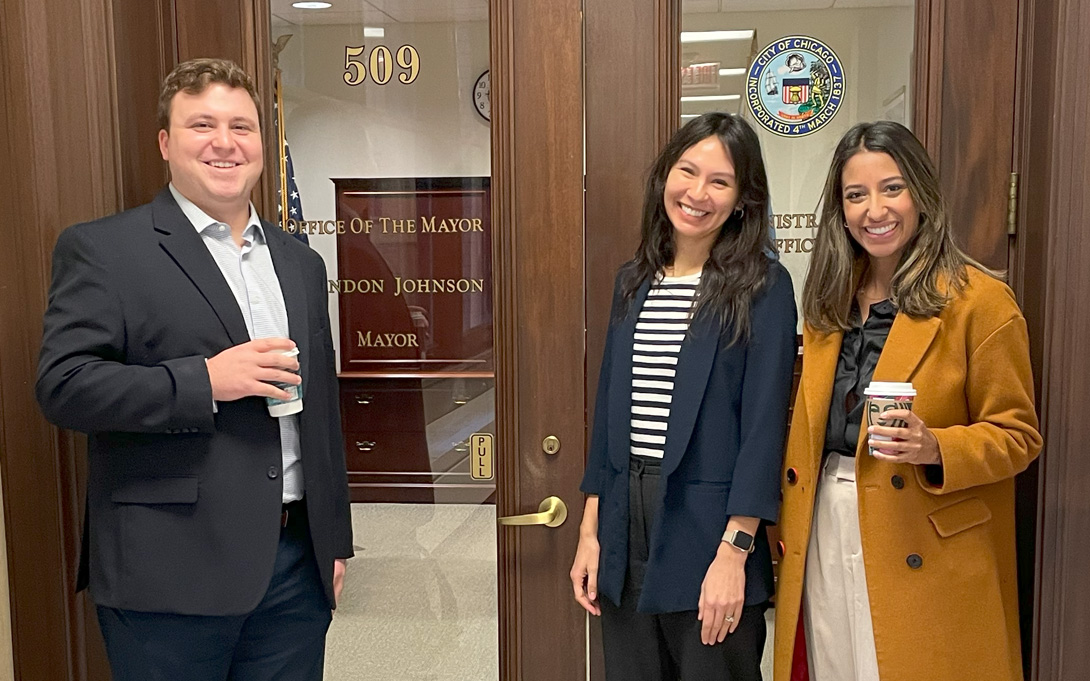
By its very definition, democracy gives people a voice in the decisions that affect their communities, but the practice of incorporating citizen voices in government decisions can be complicated and challenging.
Last semester, three students from the Ford School of Public Policy got some real-world experience in how to include community input in government projects; they created a public participation plan for the City of Chicago’s Capital Improvement Program through an independent study project with lecturer Amy Beck Harris.
Danica Swiggart (MPP ’24), Kayla Guillory (MDes/MPP ’24), and Joseph Mancina (MPP ’24) worked with the City of Chicago Mayor’s Office to develop a plan for how the city could incorporate public input in infrastructure development spending.
Ford School alum Lauren Burdette (MPP ’15), the deputy chief of Chicago’s Office of Equity and Racial Justice, and Kevin Schuster, deputy director of Chicago’s Office of Budget and Management, worked closely with the students to explain the city’s current practices in participatory approaches and decision-making; public participation and equity goals for the project; and the city, government, and stakeholder context in Chicago. In December, they invited them to present their proposal to city officials and employees.
“The students did an incredible job of using the concepts they learned in class to create a proposal to increase participation with the express goal of improving equity,” Harris said. “They conducted research, interviewed stakeholders, and really developed an understanding of what the City of Chicago was currently doing and how they could improve.”
The students learned about the budget process specifically within the city of Chicago and met with dozens of stakeholders including city officials and leaders of community and non-profit organizations. They also incorporated outside research to find the best structure for their plan.
When they had completed the plan, they traveled to Chicago to present it to city officials in person.
“It’s one thing to make a plan, but it’s another thing to create a strategy to implement it,” Guillory said. “We tried to set them up as best we could to actually put the methods we suggested into practice. It became clear that high-level framing was a really important component. We wanted to be clear about why public participation is important and why we were even talking about it.”
The plan recommended the city hold open houses paired with feedback sessions in specific wards and neighborhoods, where community members could learn about how capital improvement funds are allocated and rank top priorities for their neighborhoods. The open houses would also allow community members to share their own ideas for projects. An important element was communicating to the public how infrastructure dollars can be used, and what projects they cannot fund.
“We broke our plan down by different wards because people in each ward needed different things,” Swiggart said. “We found some wards had a lower receipt of capital funding in the past compared to others. We wanted to pay special attention to the wards that were historically underfunded.”
The students suggested the city follow up with digital engagement, such as an online survey, as a follow up tool and for community members who are not able to attend engagement sessions.
“A big challenge was thinking through how our plan would engage with the public in the most meaningful way and capture all of the voices we wanted to capture,” Mancina said. “So, we thought about how to reach people who might distrust government, or people who may not have Internet access or time to come to a community meeting.”
As a foundation for their plan, the students used the materials they learned in Harris’s course Engaging the Public in Policy-Making, which they all took before beginning the independent study.
“It was surprising how much of what we learned in the classroom was a great framework for how we ultimately designed our plan,” Mancina said. “Ultimately, the project was a great learning experience.”

